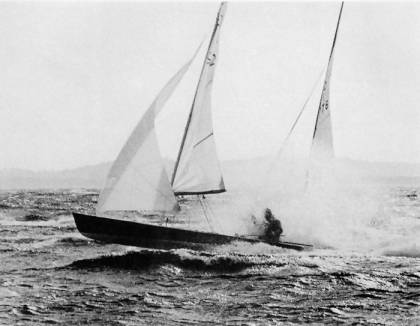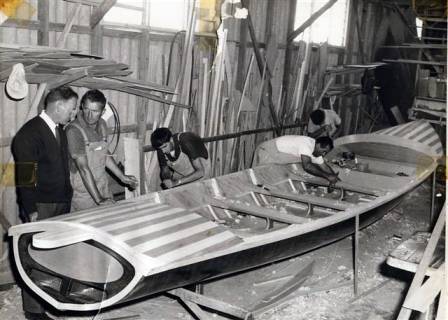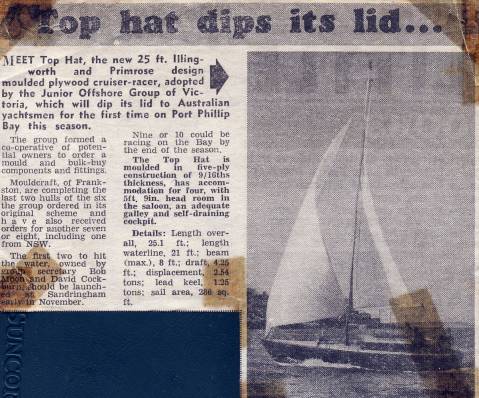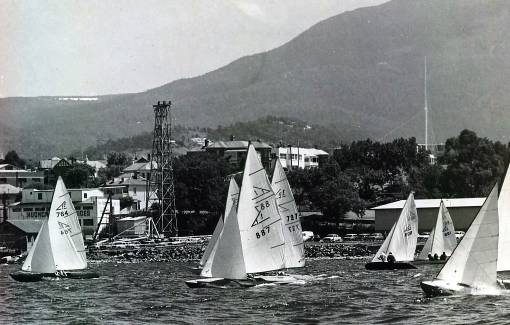"Flying Dutchman"

Flying Dutchmen were an exciting boat to sail and planed readily. Setting a spinnaker while
the forward hand was on the trapeze was a real art, and two pair of hands were never enough.
Sailing Flying Dutchmen was very hard work! Chris, my forward hand, was over six feet tall, weighed over fourteen stone, and was very fit.
A lot of the top sailors from other classes were sailing F.Ds. This was a new era, where boats belonged to an association, and were trailed around to invited events sponsored by sailing clubs all around Victoria.
At one of the first events we sailed in, hosted by the Hastings Yacht Club, we ended up in quite a lot of trouble. It had been a very blustery and hot northerly blowing, and a long course had been set out into Western Port Bay. The last beat was a long hard slog across the bay and up the channel to the finish line. The closer we got to land the harder the puffs seemed to get, and after many tacks we were getting very tired.
On clearing the last channel beacon we had one last tack to make. We went about, and Chris missed hooking onto his trapeze wire and fell over the side just as a big puff hit us. The boat capsized and I managed to straddle the gunwale. The boat on its side now blew away faster than Chris could swim after it. His only alternative was to swim over to the beacon and hang on. Meanwhile I managed to right the boat and now with the mainsail right off and the head sail sheet fouled, the boat took off for the far shore. When our predicament was seen from the club house one of the members, Tom Bartlett, who had his catamaran rigged on the beach sailed off to rescue Chris from the beacon, but when he was only yards away he was hit by a big gust and capsized too - his boat blowing away down the channel - so he also swam over to the beacon. Meanwhile I had run the boat up on a beach and could only sit and watch.
After some time the club rescue boat arrived back from picking up the course buoys with Tom Bartlett's catamaran in tow, and rescued the two hanging onto the beacon. Mike Fletcher won the race that day in "Fico".
We had learnt a lesson. We just hadn't realised how fast boats that had self draining cockpits could sail away on their sides, and that applied to catamarans too.
Rolly Tasker with Andy White up forward dominated the class up to the 1960 Olympic games. He had won the world championships in 1958, an incredible feat against some of the worlds best helmsmen, and was unbeatable in the games trials held in Melbourne.
Rolly turned up for the trials with an amazing amount of spare gear. It was rumoured that he had six spare masts, and a mainsail for each. He was not only a clever helmsman, but would play at psychological games. He would always rig his boat at the opposite end of the beach from all the other competitors, and they would all be worrying about which rig Rolly was putting up today. It got so bad that I can remember boasting about having caught Rolly on starboard during the second beat, when in fact it was the only time we ever headed him during the many heats that were sailed. We persisted for three seasons but never did better than get the odd placing.
" Surf Boats."

Old Gold, the experimental surf boat was donated by
MacRobertson's chocolates.
I thought the self draining floor made sense ! And by the way, what ever happened
to
MacRobertson's? They made great chocolates.
Surf Boats had always been designed and built in Sydney until the "Royal Life Saving Association" gave us a mandate to construct an experimental boat each year. The Point Leo Surf Club had been having trouble finding a suitable boat to suit their very rough conditions, and I was asked to design a boat that could give them an advantage. Their main problem was the big shore break that that mostly filled the boats with water before they even got going, and if they did survive that, broaching and rolling over was the hazard coming back in.
To study the problems at first hand I went down to Point Leo one weekend when a blustery southerly was blowing and hitched a ride. I was seated on the keel between the Stroke oar and the Sweep. A big breaking surf was running, and by the time we were through the third breaker, I had been kicked in the ribs by the Stroke when he was trying to get his feet into the leathers, belted in the ear when the sweep oar came out of the water, and by now was sitting up to my waist in water - we were then three quarters full of water, so they headed back to the beach . On the first wave we broached and rolled over. Here I was with one leg caught under the thwart and the boat on its side in the surf, the boat righted and I floated out.
This was not my idea of fun! And I had a new respect for boat crews.
I felt that there was a solution to their problems, and I designed a boat with a self draining floor so the breaking seas would just run straight through the boat and out through the transom. It also had a wider stern and flatter floor aft to give the Sweep a better chance to keep the boat square to the waves.
The Boat was a success, and won its first seven races, some times being the only boat to survive. But then the Sydney boats came down for the interstate competition, and when they got home the clubs got together and complained that the boat was unfair competition. To my surprise I received a letter stating that the boat would be banned from future competition as it was unsportsman-like and would ruin surf boat racing because it would spoil the spectacle for spectators. I didn't quite see the point of going to all that trouble and expense to design and build improved boats if they were to be banned.

While we were building the "Top Hats" I had played with the idea of a trailable yacht with the same accommodation,
and 24 ft in length, I had done some preliminary sketches and mentioned the idea to my partner, but he didn't like
the idea, and anyway we were really too busy to take on another type of boat, and had run out of space.
At that time we were running no less than fifteen stock models and this took a lot of keeping up with.
Also we had taken on a Mercury outboard dealership, so I had to concentrate on power boats a lot more.
Junior Offshore Group (J.O.G.) " Top Hat"
A strong JOG fleet was forming on Port Phillip bay and we were approached to build an initial six boats designed by Illingworth and Primrose. Right from the start John.Illingworth proved to be the most cooperative designer I had worked with. Nothing was too much trouble, and he had a vast practical experience. He was the man who revolutionised the Sydney to Hobart race just after the war, he brought his own boat "Rani" here for the race, and shocked everyone by actually racing right thru the night, unlike the general practice at that time of quitting till sun up.
At the time we were building the JOGs we were also setting up to build Flying Fifteens. Dealing with "Uffa Fox' was by contrast a nightmare. We exchanged rather heated letters and telegrams, and we never seemed to agree on anything. However in spite of this I did admire him greatly as a designer and builder.
After three years sailing the "Dutchman" I thought that a flying fifteen would be a nice easy change, and I was keen to go to Hobart for the 'Prince Phillip Cup', so I built myself a 'Fifteen' and I enjoyed sailing it very much. It sailed well, and was great for tactical sailing as it tacked quickly and without losing way. However it did develop a heavy weather helm in a breeze. I wrote to Uffa and suggested either moving the mast forward or the keel aft a few inches. Post haste I got a letter back. "No -----boat builder is going to tell me what to do. As long as I live my boats are never going to be changed!" It is interesting to note that soon after Uffa died the rules were changed. And I promised myself that if one of my boats was ever to become a class I would leave the rules open to improvement regardless of whose ideas they were.
"Flying Fifteens." (The Prince Phillip Trophy)

Mirage sail no 764. Twice we were hit at the weather mark by a boat on port tack.
There was snow still quite low down on the mountain at Christmas.
I hadn't really taken a holiday, (except for going to sailing events ) since the business had begun, and bookings for the ferry to Tasmania were filled between early December and January, so I decided to go over on the first week of December with the boat, and have a look around before the racing began in January. My crew would fly over in time for the first race.
Snow was still on Mt Wellington when the racing started, and the water in the Derwent River was bitterly cold.
Four States were represented, and the competition was surprisingly close. We managed to win the invitation race and the first three heats. In the fourth heat another Victorian boat collided with us on the weather mark and broke our shroud. It was the second time he had hit us. Our protest allowed us a re-sail of that heat, and we had to replace the shroud before the next morning's race.
As it turned out I had made a big mistake in calling for a re race. A mistake had been made by the chandlers and the new wire was an inch and a half too long, they had taken a measurement from the end of the swage, and not to the end of the eye, so we sailed the next two races that day with the mast hanging over to port, and the boat would not perform, and we lost those last two heats to the boat that had dismasted us. He ended up winning the Prince Phillip Cup.
The rules for the race had stated, "The points for the best four races were to count, but a boat that had been disqualified could not drop the disqualification." If we had not been too cocky, and asked for a re race, then the other boat would have had to drop another race, leaving us enough points to win the series. As it was I wasn't too unhappy. We had built the first four boats anyway.